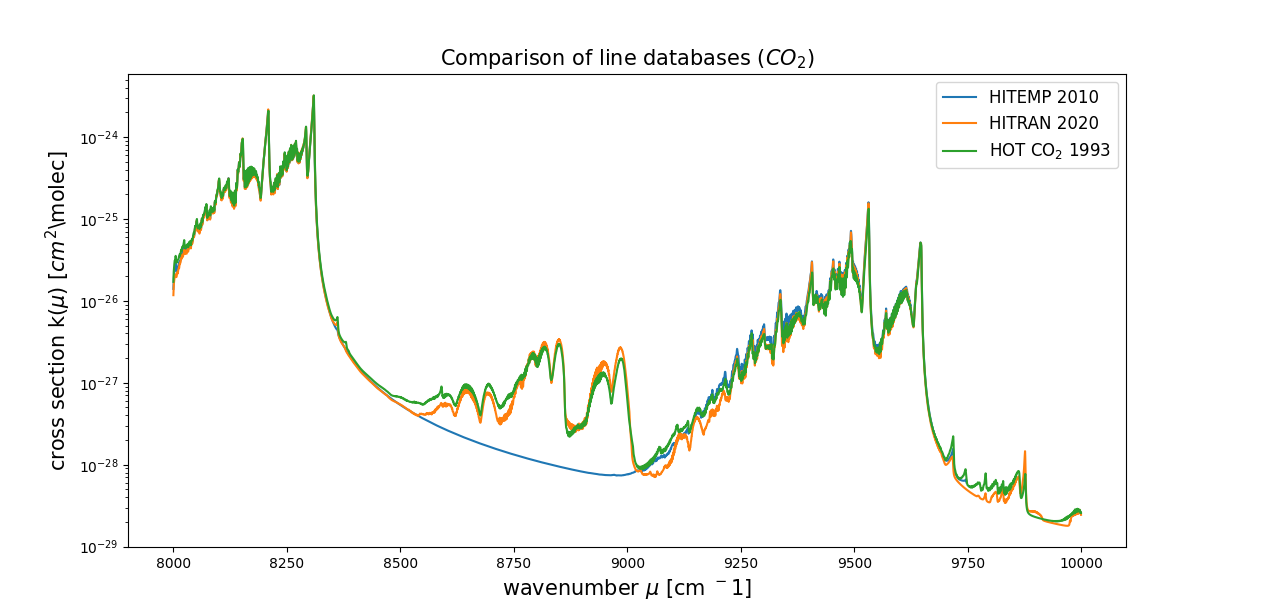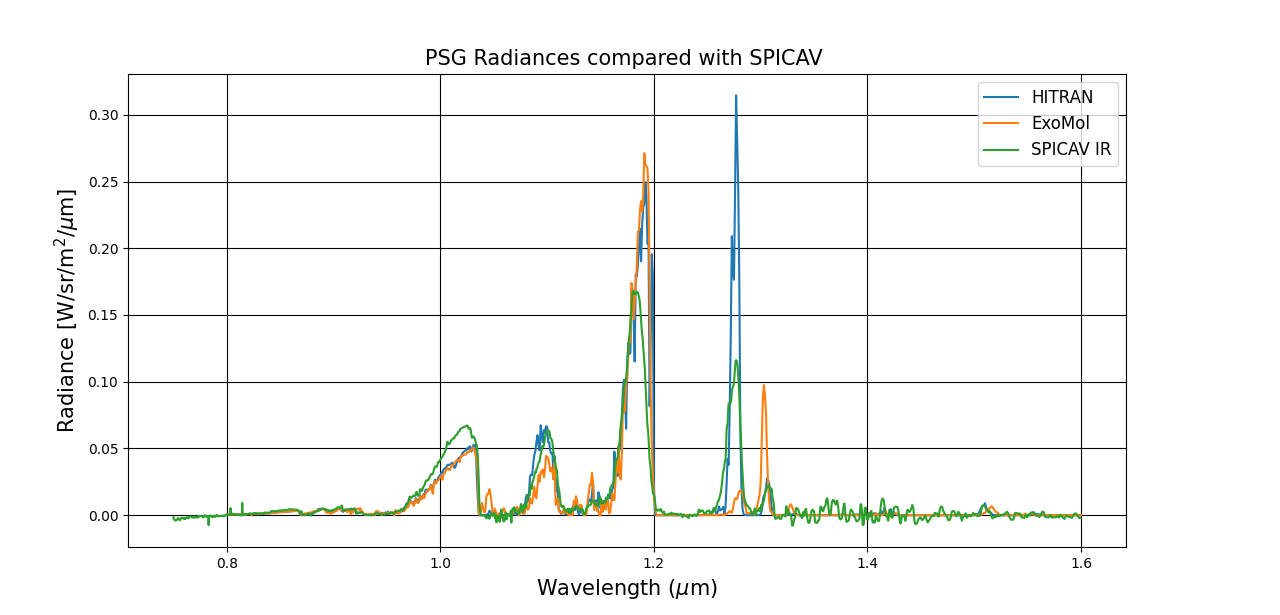Radiative Transfer Modelling of Venus – A comparison of line databases
- 1Freie Universität Berlin, Institute of Geological Sciences, Department of Earth Sciences, Germany (ankita.das@fu-berlin.de)
- 2Institute of Planetary Research, German Aerospace Center (DLR), Rutherfordstrasse 2, 12489 Berlin, Germany
- 3Remote Sensing Technology Institute, German Aerospace Center (DLR), Oberpfaffenhofen, D-82234 Wessling
- 4Institute of Physics and Astronomy, University of Potsdam, Karl-Liebknecht-Str. 24-25, 14476 Potsdam, Germany
Introduction:
The Venusian atmosphere is a fascinating object of interest to planetary scientists. Obtaining in-situ data from Venus’ atmosphere and surface is however challenging. Radiative transfer (RT) modelling is an essential tool to understand planetary atmospheres. In a nutshell, radiative transfer codes model absorption, emission, and scattering of light by various components present in the atmosphere and surface. Accurate modelling of the atmosphere is also essential for decoding surface information from remote sensing data collected by probes. In the coming decade, several missions to Venus are planned that aim to image Venus thermal emission in the NIR spectral windows [1]. In order to process the data from these missions once they are available, radiative transfer modelling of the Venusian atmosphere is a necessary first step. One important aspect of the model is absorption by gases. Modelled absorption cross-sections are governed by the line list chosen for the model. These line lists are provided for wavelength ranges over which absorption occurs. The high-resolution transmission molecular absorption database (HITRAN) is a frequently used line database in radiative transfer modelling [2]. Several Venus atmospheric studies [3], however, have relied on the database of [4] for CO2 lines, referred to as “Hot CO2” from here on. This database is structurally similar to high-temperature molecular spectroscopic database (HITEMP) [5]. Fortunately, due to advances in exoplanetary sciences, newer line databases have been developed for high temperature atmospheres which are yet to be applied to Venusian atmospheric studies. In this work we compare absorption cross sections generated by using different line databases for relevant species present in the Venusian atmosphere: HITRAN 2020, HITEMP 2010, Hot CO2, and ExoMol [2,4,5,6]. Additional comparisons are made between radiance spectra generated by radiative transfer methods using different line lists with measured spectra in the NIR wavelength range.
SPICAV dataset from Venus Express:
The NIR wavelength range of 0.8 – 1.2 micron contains spectral windows where Venus’ surface thermal emission radiation is detectable from space, paving the way for surface studies in these bands [4]. Hence, the NIR region of Venus’ spectra is of particular importance. The Spectroscopy for the Investigation of the Characteristics of the Atmosphere of Venus (SPICAV) suite on board Venus Express made observations of Venus’ nightside in the spectral range of 0.65–1.7 um. The data used in our analysis is detailed in [7].
Materials and Methods:
The following computational tools have been utilized in this work: PYthon for Computational ATmospheric Spectroscopy (Py4CATS) [8] and Planetary Spectrum Generator (PSG) [9]. Both Py4CATS and PSG are equipped to read various line lists to produce radiance spectra from calculated absorption coefficients for a specified atmospheric profile. PSG is an online multi-purpose tool capable of computing radiance and transmission for planets and exoplanets with preconfigured settings. Py4CATS implements several scripts for radiative transfer calculations which can be executed from a Python interpreter or from a console. PSG includes a module capable of modelling scattering in the Venusian clouds while Py4CATS has to be combined with additional tools to do so, e.g. [10].
Preliminary results:
In the Venusian atmosphere, absorption features are majorly dominated by CO2 and H2O lines. Thus, we start by comparing absorption cross sections for CO2 computed by Py4CATS for the following line databases: HITRAN 2020, HITEMP 2010, and Hot CO2. From figure 1, one can note that HITEMP 2010 has missing lines in the 8500 – 9000 cm-1 wavenumber region and that absorption cross sections produced from HITRAN 2020 are much closer to those of Hot CO2. This work aims to further explore implications on radiative transfer modelling using recently updated line databases such as HITRAN 2020 and ExoMol.

Figure 1: Comparison of line databases in NIR region generated using Py4CATS, computed for575 K and 2x106 Pa
To decide which database is best suited it is necessary to compare modelled top of atmosphere radiances to observed spectra. We use the PSG to model nadir radiances of the default Venus atmosphere profile and modules (i.e. Lambertian surface with emissivity 0.8, absorption by gases, Rayleigh scattering, multiple scattering at cloud droplets with cloud optical thickness 15). Figure 2 shows that there are noticeable differences in the radiance spectrum generated by the PSG [9] upon using HITRAN 2020 line database and the ExoMol line database.

Fig 2: Radiance spectra generated by PSG (HITRAN 2020 and ExoMol) compared to SPICAV IR data.
It can be noted from figure 2 that radiances generated using HITRAN 2020 database to have a better agreement with SPICAV data than those generated using ExoMol database. It is likely that further modifications to the line shapes and continuum absorption similar to those that are used in other Venus studies will have to be introduced [3, 11].
Conclusions:
The HITRAN 2020 line list is closer to the often used ‘’Hot CO2’’ line list than previous versions of HITRAN. Line databases such as ExoMol which are intended for high temperature atmospheres may improve radiative transfer models for Venus, although our initial comparison does not show an improvement over HITRAN. Overall our investigations have shown HITRAN 2020 to be more promising for Venus RT studies than HITEMP 2010 and ExoMol. This work aims to further explore applying these new databases to radiative transfer models and compare generated spectra to measured data.
References:
[1] Allen D. A. et al. (1984) Nature, 307, 222–224
[2] Gordon I. E. et al. (2022) J. Quant. Spectrosc. Radiat. Transfer, 277, 107949
[3] Bézard B. et al. (2011) Icarus, 216(1), 173–83
[4] Pollack J. B. et al. (1993) Icarus, 103, 1–42
[5] Rothman L. S. et al. (2010) J. Quant. Spectrosc. & Radiat. Transfer, 111(12-13), 2139–2150
[6] Tennyson J. et al. (2016) J. Mol. Spectrosc., 327, 73 – 94
[7] Korablev O. et al. (2006) J. Geophys. Res. 111(E9)
[8] Schreier F. et al. (2019) Atmosphere, 10(5), 262
[9] Villanueva G. L. et al. (2018) J. Quant. Spectrosc. & Radiat. Transfer, 217, 86 – 104
[10] Efremenko D. et al. (2023) Environmental Sciences Proceedings , 29(1), 20
[11] Kappel D. et al. (2016) Icarus 265, 42–62
How to cite: Das, A., Mueller, N., Schreier, F., Kappel, D., Grenfell, J. L., Rauer, H., and Helbert, J.: Radiative Transfer Modelling of Venus – A comparison of line databases, Europlanet Science Congress 2024, Berlin, Germany, 8–13 Sep 2024, EPSC2024-1078, https://doi.org/10.5194/epsc2024-1078, 2024.